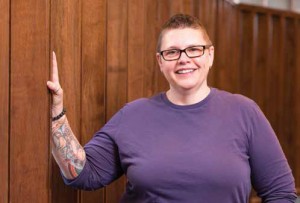Catherine Maser didn’t want to work with adolescents. She was quite content providing nursing care in the emergency department at the Hospital for Sick Children. “I thought adolescents would be too challenging, and I didn’t understand the population,” says Maser, MN 2007. “But I kept getting assigned to youth when I started practising in the general paediatric ward, I guess because of my hairstyle and piercings.”
Fast forward 28 years, and today Maser is an award-winning nurse practitioner in the hospital’s Division of Adolescent Medicine. She wouldn’t think of working with any other age group. “Adolescent care is incredibly rewarding,” she says. But like many other health care providers, Maser found that providing care to adolescents wasn’t as intuitive as, say, caring for cuddly babies. Maser had to learn how to best communicate with patients who have one foot in adulthood and one foot still in childhood.
Barriers to effective practice, she says, include buying into negative stereotypes of teenagers as irresponsible party-goers, and the tendency to talk down to them or over them to their parents. “Rapport building is 80 per cent of what I do,” says Maser, the team lead of SickKids’ Interprofessional Team for Youth (SITY), which handles 1,200 patient visits a year. “You’ve got to be authentic. If you’re not being yourself, adolescentswill smell the insincerity. If you’re cool, be cool. If you’re a geek, be a geek.”
Words from the wise
As a U of T Nursing lecturer, Maser challenges students to develop an understanding of the relationship between a youth’s health and his or her socioeconomic context. She helps them explore how social class, gender, migration, race/ethnicity, ability/disability and sexual orientation come together to affect the ability of an adolescent to access adequate health care.
Last year, Maser was appointed co-ordinator of Bloomberg’s Nurse Practitioner Program, Paediatric Emphasis. In this role, she ensures that education about the psychosocial issues that young people face is incorporated into all streams of the nurse practitioner curricula.
“You have to ask adolescents about sex as early as when they’re 14 or 15,” she instructs. “You could ask, ‘Do you have any romance in your life?’ Be careful not to make an assumption about heterosexuality. Instead ask, ‘Would you date a guy, a girl or both?’”
My love life
If a teen’s parents express horror at a health care provider asking their child about his or her sexual orientation, Maser explains that one of her reasons for asking is to identify the youth’s risk of suicide. Lesbian, gay and bisexual youth have about a 28 per cent risk of attempting suicide, compared to four per cent of heterosexual youth. “It’s imperative that adolescents know it’s OK to speak about sexuality in the context of health care,” Maser says.
At an age when they want to fit in by being just like their peers, an adolescent’s sexual identity can make him or her feel different. Without models of healthy same-sex relationships, youth can feel isolated, ashamed and terrified that their sexuality will be discovered. If they do “come out,” they could become a victim of bullying (including cyber bullying) at school, increasing their risk of academic failure or school avoidance.
“A huge stressor for gay adolescents is a lack of support from parents and other family members,” says Maser, adding that lesbian, gay, bisexual and transgender (LGBT) youth are more likely than heterosexual youth to be harassed at home, kicked out and forced to live on the streets.
“Above all, be nonjudgmental when you work with adolescents,” says Maser. “Think of how many nonjudgmental adults there are in an adolescent’s life – very few, if not none. So when you meet with adolescents, you need to let them drive the bus.”
Gender independence
In a webinar on LGBT health for students studying to be NPs, Maser spoke on the unique challenges of transgender youth. “For this population, adolescence and especially puberty is the most distressing time,” says Maser. “They face multiple psychosocial problems, including family and peer harassment, if not rejection.” A study of transgender 16- to 24-year-olds in Ontario found that 50 per cent had seriously considered suicide.
In 2013, Maser helped initiate the Transgender Youth Clinic at SickKids to meet the medical needs of the population. To address some of their psychosocial needs, Maser and her colleagues worked with community providers in 2014 to start a peer support group for 13- to 15-year-olds attending the SickKids clinic. To recognize this accomplishment, Planned Parenthood Toronto gave Maser and team the Service Provider of the Year Award.
Hardwired for what?
At SITY, Maser meets with youth who have a variety of concerns, including anxiety, social phobia and chronic illness. Other adolescents arrive overwhelmed with information and opportunities, but without the tools to navigate the landscape of possibilities. Some try to self-medicate their angst with alcohol or other drugs, which concerns Maser. “The worst time to use substances is in adolescence because they’re developing neural pathways which make them extremely susceptible to substance misuse and addiction,” she says. “The brain doesn’t fully develop until you’re 24.”
Maser goes on to explain that the brain develops from the back to the front. “The front of the brain is the reasoning part – the part that asks, ‘What happens if …’ – and it isn’t fully functioning. In youth, the amygdala in the brain stem is often what’s firing. The brain stem is reactive. It’s about impulses, emotions, being spontaneous and taking risks. Since the dawn of time, high-risk behaviour has been a normal part of adolescence. But with support and accurate information, most adolescents can learn to navigate the complexities of the world and be healthy and successful.”
This story originally appeared in the Spring/Summer 2015 issue of Pulse Magazine.
Cover Photo: Nadezhda V. Kulagina
